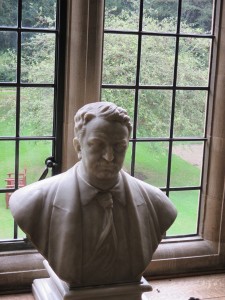 A matrix: people, organisations and letters
A matrix: people, organisations and letters
Please reference as: Liz Stanley (2017) ‘A matrix: people, organisations and letters’ Whites Writing Whiteness www.whiteswritingwhiteness.ed.ac.uk/curiosities/colossusvalmighty/ and provide the paragraph number as appropriate when quoting.
1. It is almost impossible to engage with late 19th century southern Africa without the spectre of the imperialist entrepreneur and politician Cecil John Rhodes looming large. At Rhodes House, Oxford, his bust (pictured left, one of many such) for many generations symbolically cast a pupil-less eye over the researchers who ascended the staircase to reading rooms which used to house the Bodleian Library’s Commonwealth and African Studies collections (until the 2015 opening of the Weston Library when these moved). His symbolic presence is still felt.
2. The many biographies of Rhodes lean towards the hagiographic, particularly the suite of ‘rememberance’ style offerings written in the years following his death in 1902. The ‘Rhodes Colossus’, a famous and evocative cartoon by Edward Linley Sambourn portrayed a giant Rhodes straddling the length of Africa and was first published in Punch magazine in 1892. It has subsequently provided a key metaphor for the interpretation of Rhodes by many commentators, both during and after his lifetime.
3. Of course, adopting a positive take on this is not the position of every commentator and biographer, and there is a later, more critical literature which casts a very different light on Rhodes and his activities. This kind of ‘after the event’ deconstruction of a life is of course quite usual, especially regarding historically important figures. But perhaps less commonly realised, there is considerable evidence of an ‘at the time’ questioning of the ‘greatness’ of Rhodes. In this respect, feminist and socialist writer and social theorist Olive Schreiner certainly had her finger on the pulse with regards to cracks in the ‘Rhodes Colossus’ characterisation. Writing to her brother Will Schreiner in August 1895, for example, she described Rhodes as “an almighty, might-have-been”, and recognised his failure to become “all that was best & greatest in South Africa”, that is, as a positive force in the social and political structuring of turn of the century South African society:
“…I sometimes fear Rhodes is coming near the end of his course. And it need not have been! He might have all that was best & greatest in South Africa to his side. ‘We that would have loved him so, honoured him, followed him!” – but he has chosen, not only to choose the worst men as his instruments, but to act on men always through the lowest sides of their nature, to lead them through a narrow self-interest instead of animating them with large enthusiasms….And he might have done it! – Fort says he couldn’t that I am mistaking his nature. It may be: if so I am yet more mistaken in his nature than I thought. For the present I feel to him not as to a man who has only one path open to him, but as to a man who had, & who has looked steadily & carefully at both, & chosen the lower! He is to me an almighty, might-have-been….” (To Will Schreiner, 13 August 1895: Olive Schreiner BC16/Box1/Fold2/1895/9)
4. Such ‘at the time’ and ‘in the midst’ of action and circumstance interpretations are one of many reasons why letters form a major source of data for the Whites Writing Whiteness project. And for more of Schreiner’s razor sharp analysis of Rhodes both the man and the matrix, see the Olive Schreiner Letters Online at http://www.oliveschreiner.org
5. The WWW interest in the ‘Rhodes Papers’ in the Bodleian Library collections exists because these enable exploring Rhodes’ organisational involvements and the networks of letter-writers and kinds of letter-writings (including the use of telegrams, the writing of reports, the drawing of maps, the use of lists and inventories, the record of legal claims, and so on) that were involved in forwarding these involvements. While Rhodes ‘the man’ is both fascinating and appalling, conceiving of Rhodes as representing ‘a matrix’, as Olive Schreiner put it, of organisations, people, interests and power-bases, and letters abour all of this is much more revelatory about the occurrence of social change in South Africa in the late 19th century, which is a core aspect of the Whites Writing Whiteness research. Consequently, an annotated reading list is available here: Rhodes: Man, Myth and Matrix. And there is also a Project research essay reflecting on some of the methodological and related issues arising from thinking about the Rhodes Papers, available here: Rhodes the Matrix.
6. The Rhodes Papers have been worked on in depth as part pf WWW research. Details of how it was sampled and analysed will be found in the Collections part of the WWW website. The Rhodes and other African manuscript collections are located in Special Collections in the Weston Library, Broad Street, Oxford. Details are available from the Oxford Libraries website.
Last updated: 23 December 2017





